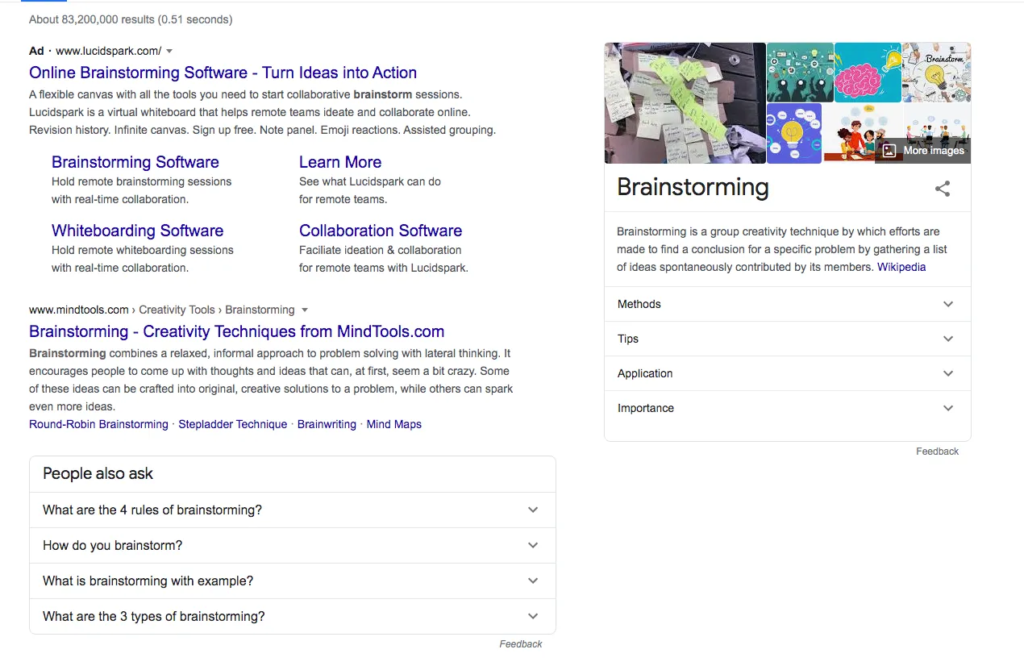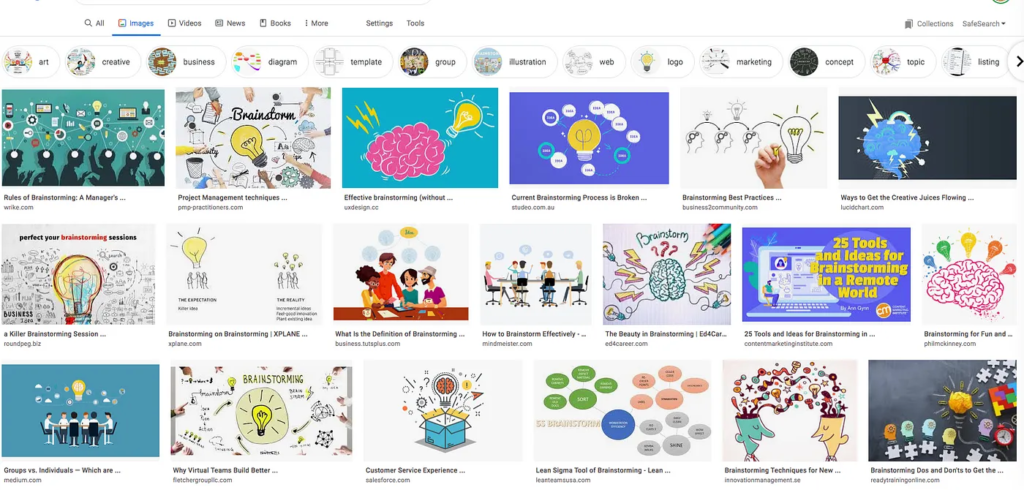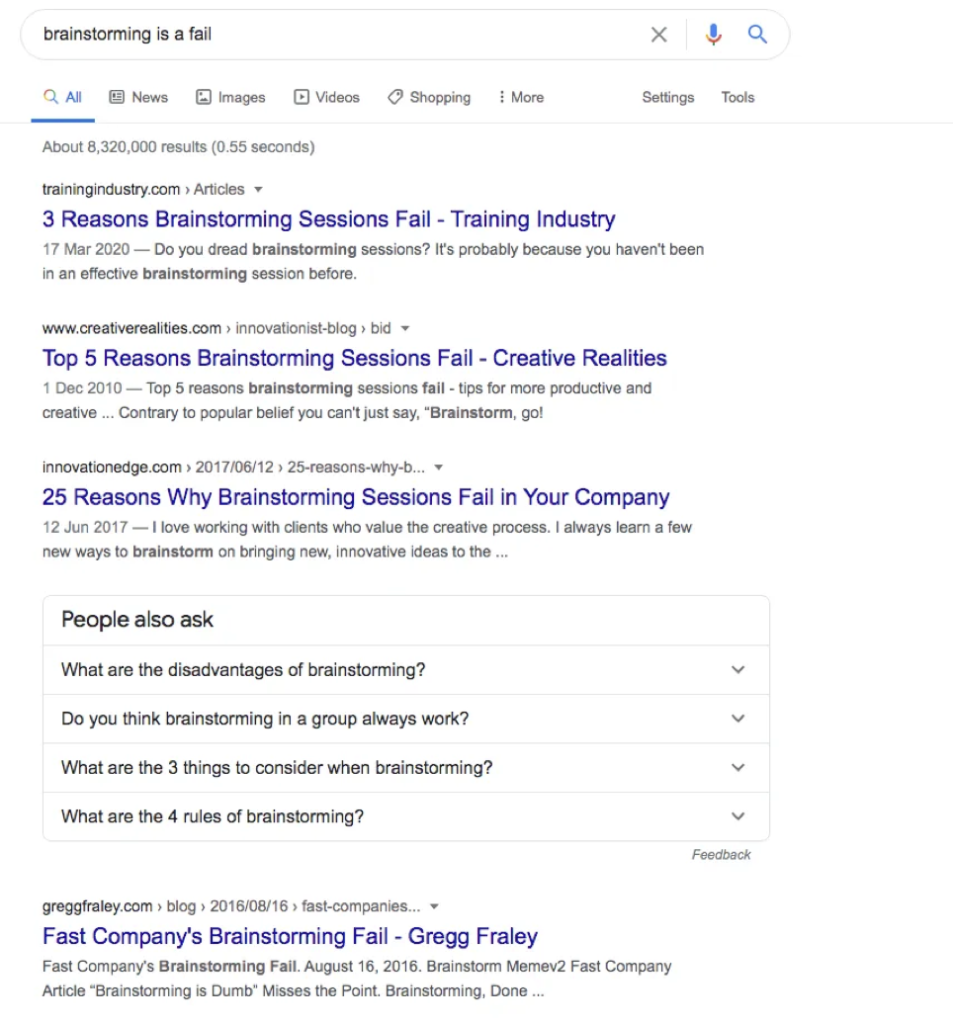Merely mention Brainstorming, and you will see an equal number of eye rolls and hopeful eyebrow lifts.
Table of Contents
# What is it?
It is a session that helps generate innovative ideas. It’s one of many ideation methods for developing new ideas and is core to the design thinking process.
It’s trendy for teams because it can extend in all directions. However, it’s a skill that can be built within groups and organizations to help bring new ideas to life.
# Alex F. Osborn: Coined the term
The term was invented by Alex Osborn, an Adman at BBDO, who first described the process in his 1942 book “How to Think Up”. It was further expanded in his 1963 book “Applied Imagination”.
At BBDO, it consisted of two principles: Defer judgment and Go for quantity. For decades, these two principles have been used and followed.
# Why have a session?
- Cultivate a large number of ideas.
- Develop ideas quickly
- Get people unstuck
- Infiltrate insights from a broader group
- Create enthusiasm
- Solve tricky problems
- Improve team collaboration

# Who are the people who believe in it?
Here’s who typically suggests the traditional group brainstorming session works.
- Bosses and executives
- Managers who need to produce a “breakthrough.”
- Some researchers are trying to prove it has merit
- Extroverts
People mentioned above want solutions but need to know the answer. These are only sometimes charged with generating ideas to solve problems. But they do have people who can help.
There’s nothing wrong with that; it’s an excellent position to be in: “Get the most relevant people to the problem”.
They have an elementary understanding of Brainstorming; for some reason, it involves a group of people, a safe space, a growing list of ideas, and one person writing those down as the writing space fills up.
What works for them
- A brainstorming session produces a large number of ideas
- Generate ideas quickly
- Expand your portfolio of alternatives
- Get people unstuck
- Inject insights from a broader group
- Build enthusiasm
- Solve tricky problems
- escalate team collaboration
# Who are the people who don’t believe in Brainstorming?
- Introverts
- Knowledge hoarders
- control freaks
- people who discredit wisdom
Think about what you would do in a group Brainstorming in the first place. It comes down to a straightforward premise.
What you want is a process that makes that happen. Creating becomes a skill rather than a talent for folks who generate daily. That makes group brainstorming largely unnecessary.
# What doesn’t work for them?
- The initial idea often sparks the concept of reproducing or being influenced by thoughts.
- Prevent your over-enthusiastic colleague from expressing their opinions or bullying behaviour.
- People at the company tend to refrain from expressing their thoughts and ideas due to a fear of appearing foolish, leading to limited thinking.
- When individuals experience evaluation apprehension, they may become hesitant to contribute to a discussion, resulting in a lack of participation and potentially causing the conversation to stand a standstill.
- Instead of serving as a source of inspiration, it is better to use it as a to-do list for starting any project.
- When someone focuses on generating unreasonable ideas to “go wide,” it can make others feel like the session wastes time.
- The pressure to be socially accepted often leads to repetitive thoughts, as people tend to offer variations of already popular ideas instead of something new in the hopes of being liked.
- When people contribute little to a group project, it’s called social loafing. This can hurt the group’s success and productivity because it makes people feel they don’t have to do their fair share. Everyone needs to participate and do their part to avoid this problem.
# What is a successful Brainstorming Session?
Compilation of Alex Osborn’s idea and rules of Ideo
Stay focused on the topic; start with a problem statement, Point of View, How Might We question, a plan, or a goal during brainstorming sessions.
It is recommended by Alex Osborn, the creator of the Brainstorming technique, to focus on a specific question or problem statement to remain on course.
Creative spaces are Free from judgment, where people can freely share their ideas and build upon each other’s brilliance without fear of judgment. It’s essential for everyone to feel safe and secure in this environment.
Encourage weird, wacky, wild ideas; embrace the most out-of-the-box notions. It can be challenging to tell if a picture is crazy or innovative. However, thinking about unconventional ideas can help us come up with creative breakthroughs.
When we imagine ideas outside the box, we focus on what we want without worrying about limitations like technology or materials.
Go for quantity; aim for as many new ideas as possible. Creating more pictures increases the chance of finding a good solution.
Build on the ideas of others; it’s better to use “and” instead of “but” as it promotes positivity and inclusivity, resulting in numerous pictures. Our thoughts can lead to more views, but we can expand our thinking by considering other people’s ideas.
Be visual; stick your ideas on the wall so others can visualize them. Drawing takes time to get an idea across.
# What does a Brainstorming session yield?
Every team member is unique; every member of your team can solve the day’s problems. This is because they understand their thinking. They know how to consider a problem and visualize possible solutions.
Trust in individuality. Hiring capable people and trusting them to think independently is essential to develop creative solutions. Encouraging everyone to contribute their ideas leads to more efficiency and a more comprehensive range of options. It’s not just about setting rules in meetings.
To make somebody’s personal efforts more meaningful and successful, clearly articulate the situation and the conditions for ideas.
Responsibility for the session: Brainstorming has a long history of misapplying the power of the group. By shifting the burden of the group experience away from creative vision and towards evaluation, invest them with a completely different status.
They are free to study, question, wonder aloud, debate, discuss, and eventually help the person with the original idea better understand their path.
Set expectations; rather than getting everyone jointly to brainstorm, give them the prerequisites ahead of time, ask them to work up ideas independently, and then ask them to share their best or worst ideas and launch them to the group for discussion, analysis, and feedback.
Mr Brainstorming
He is just so Contentious. Merely mention his name to your party guest, and you will see an equal number of eye rolls and hopeful eyebrow lifts.
Over the years, he has gained an arrogant stature as a master problem solver and essence-sucker scammer. As a result, people rush to defend or defeat its very existence.
So, what’s the deal? Which reputation is deserved? Does it work or not? Like average netizens, let us conduct background searches and research about Mr Brainstorming.
Mr Brainstorming has skills that can be built within teams and organizations to help bring new ideas to life.
Let’s type “brainstorming” into the Google search engine and see text and image results. Here’s what I get:
A whopping 83,200,000 results, which include a Brainstorming software (not bad Mr Brainstorming) that can turn ideas into actions and brainstorming creative tools too.

A somewhat colourful personality, Mr Brainstorming, with a group of people, together chitter chattering. I can see images where Mr Brainstorming is exchanging knowledge of brain fluids with others and a lot of light bulbs and coloured pencils.

Eventually, we return to the simple definition, “group discussion to produce ideas or solve problems“. All we need is a room and many people, and it’s Brainstorming time.
The most straightforward definition for Brainstorming is “group discussion to produce ideas or solve problems.”
So, Mr. Brainstrom is very friendly and social. He wants the company because being alone in a room feels strange.
Let’s type “brainstorming is a fail” into Google search engines and see the results. Here’s what I get.
Boom!! 83,200,000 results. The results are not just from individuals trying to win the SEO content marketing game. We got pieces from publishing platforms and company blogs.

Ahh! The top consequence is Scott Adams’s Dibert comic strip, jesting about Brainstorming. There are also crazy graphics, post-it notes on the wall, and a presentation slide about failed Brainstorming.

Read more articles exploring the dynamic interplay between design, user experience, artificial intelligence, and technology here.





Leave a Reply